Yamaha CX-A5100 Atmos 11.2 Processor & 11ch Amplifier!!
R50,000.00
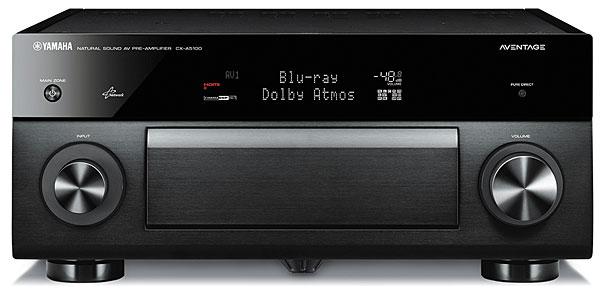
PRICE $3,000AT A GLANCE
Plus
Audiophile sound quality
Best-in-class control for iOS and Android
Dolby Atmos and DTS:X support
Built-in MusicCast multiroom audio
Minus
Slow to lock onto HDMI signals
YPAO doesn’t equalize below 31 Hz
THE VERDICT
Yamaha’s Aventage CX-A5100 is an incredible value in the sub-$5,000 pre/pro market, with stellar audio and a suite of usable features to keep an A/V enthusiast happy until the next upgrade cycle comes around.
Amazingly, you can buy a pretty damn good AVR these days that’s Dolby Atmos–enabled for under $500, so why spend more if you don’t have to? Well, there are many reasons: better-quality DAC chips, enhanced features (such as multiple zones for both audio and video), and more channels of audio and associated amplification. You can also usually count on these upgrades when you move into the realm of the preamp/processor (also known as a surround processor), though with pre/pros, you’re left on your own for the amplification. It’s kind of like an impromptu college party that advertises BYOB—except, it’s BYOA: Bring Your Own Amp(s)!
Unlike the AVR market, however, your options are somewhat limited when shopping for a pre/pro, especially in the $1,000-to-$5,000 price range. There are three major players here—Yamaha, Marantz, Onkyo (and its sister brand Integra)—as well as lesser-known products from some Internet-direct companies.
The three majors all offer Atmos-enabled pre/pros with a bevy of similar feature sets, but only Marantz and Yamaha so far have promised an upgrade to the Atmos competitor DTS:X. The Yamaha CX-A5100 sits in the middle of the pack price-wise at $3,000 (not counting a limited-time Yamaha promotion that brought it to $2,500 as of early November). But it offers a boatload of features to accompany its flagship status in the company’s Aventage line of products.
Black Is Beautiful
The “fit and finish” of the CX-A5100 is outstanding; it’s definitely built like a tank. The classy aluminum front panel is what you’d expect at this price point. The enclosure features a sturdy frame with an H-shaped crossmember for rigidity. Attached to the center of the underside of the chassis is Yamaha’s proprietary ART (Anti-Resonance Technology) Wedge, which acts not only as a supportive fifth foot, but is claimed to provide vibration control for the internal circuits. These circuits include ESS9016 Sabre32 Ultra DACs on all channels, Bluetooth and Wi-Fi for wireless music streaming, Yamaha’s new MusicCast multiroom audio support (untested here, but see sidebar on page 41), and HDMI 2.0a (with HDCP 2.2) supporting both 4K and HDR (High Dynamic Range).
The front panel is well designed and a breeze to navigate. It includes an easy-to-read LCD screen (something that’s becoming more important to me the older I get), a power/standby button, an input selector on the left, a sturdy volume control on the right, and a tiny Pure Direct button on the upper right. There’s a flip-down panel on the center of the unit that hides various controls and ports, including a front-panel HDMI input, a headphone jack (gold plated), and a USB input.
The rear panel isn’t quite as crowded as what I’ve seen on other pre/pros, and that’s a good thing. There is enough connectivity for the vast majority of enthusiasts, including seven HDMI 2.0a ports with HDCP 2.2 and two HDMI outputs (multizone compatible) on the rear panel. Balanced and unbalanced analog audio outputs are provided for all 11 channels plus dual subwoofers (13 outputs in total—an upgrade over the last generation of Yamaha pre/pros). The unit also includes a single balanced analog audio input that’s intended for high-performance stereo source components with compatible outputs, such as some CD/SACD or universal disc players like the Oppo BDP-105D. With 11.2 channels of support, you can choose to have a traditional Atmos setup with four overhead speakers or use four height speakers (two front, two rear) to utilize the wealth of Cinema DSP modes that Yamaha is famous for. The DSP modes work with Atmos as well, but they still sound gimmicky to me either way.
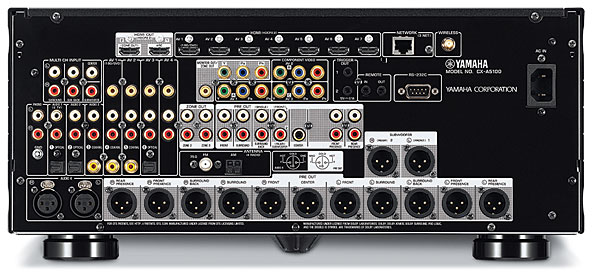
Other rear-panel connections include an Ethernet port, dual 12-volt trigger outs, an RS-232C port for control systems, and a wireless antenna. You also get a phono input and ground screw; who would have thought that vinyl would be making such a comeback?
Video processing is handled by a proprietary solution and supports 4K Ultra HD video (native or scaled), and it can pass through the signal unmolested if you use an outboard processor or are pleased with the way your display handles content of varying resolutions. As you’ll see in the Test Bench results, the processor fared quite well, other than failing the 2:2 HD test (a common failure), and it handled the luma and chroma signals with no rolloff.
You can connect the Yamaha to your home network either wired or wirelessly, and with its DLNA (Digital Living Network Alliance) compatibility, it can stream virtually every audio format you can throw at it, including WAV (PCM format only), MP3, WMA, MPEG-4, AAC, and FLAC (one or two channels only). It can accommodate sampling rates of up to 192 kilohertz for WAV, FLAC, and AIFF files and up to 48 kHz for others. You can also stream music directly with Internet Radio as well as Pandora, Spotify (premium account required), Rhapsody, and SiriusXM. For those who are part of the Apple ecosystem, it has AirPlay as well. No need to get up from your couch and change CDs anymore; no wonder Americans have put on so much weight! This convenience extends to the unit’s MusicCast functionality, which allows the CX-A5100 to act as an app-selectable zone for playback of other networked sources through your theater system, and also lets MusicCast-compatible speakers in other rooms tap into the various sources connected to the pre/pro.
The stock remote appears to be the same model that came with the predecessor CX-A5000 (Sound & Vision, January 2014, soundand- vision.com), and it’s more than functional. I love its backlit design and sturdy build quality. The major keys are easy to locate by touch, but the inputs are labeled by number instead of device name, so the baby sitter may need to undergo some trial and error to find the right input for the cable box.
Yamaha’s stellar control app supports multiple platforms, including Android and Apple. It can power the unit on and off, set the volume and input, and choose any of the 33 DSP programs. I used the iOS app on my iPad and was amazed at how quickly the unit responded to commands, especially when I changed audio tracks streamed from my Windows Home Server.
The YPAO-R.S.C. room-correction software is proprietary to Yamaha, and the CX-A5100 ups the ante on other Aventage-branded products with a new 64-bit version (versus 32-bit). This allows the unit to apply correction to lossless files at full 192-kHz/24-bit resolution without decimation/downsampling— something that most other EQ solutions can’t do (they often decimate/downsample to 48 kHz). Like previous versions of YPAO-R.S.C., the software analyzes the acoustics in the room via up to eight microphone positions and also performs speaker angle measurements, then calibrates the audio parameters to achieve optimum sound. The R.S.C. attempts to correct for any early reflections, and it also provides DSP Effect Normalization, which varies the Cinema DSP parameters according to the reflective nature of your room.
The process takes about 15 minutes to measure eight positions and is well worth the effort, for various reasons. First and foremost, it nailed the distance of my speakers from my main listening position to within 1 inch and saved the time of having to enter this information manually. Furthermore, it did a commendable job of setting speaker levels in my room, which I verified with my SPL meter.
But always double-check all the settings. The YPAO software initially set my center speaker to large and my front left and right to small, which was a head-scratcher, considering that all three are identical M&K S150 speakers. Additionally, it set two of my four Atmos speakers (Atlantic Technology IC-OBAs) to large as well. I manually set all of them to small and set all crossovers to 80 hertz per THX’s recommendation.
 Additionally, when I went through and looked at how each speaker was set via the EQ, I noticed that there were only very slight changes made to my main speakers and virtually none to my dual subwoofers. This could be because my room is treated already and was in little need of adjustment, though YPAO as executed here won’t EQ bass frequencies below 31 Hz, where some rooms might have issues. For those inclined, with the proper calibration equipment, the EQ can be set manually with a plethora of adjustments at your disposal. If I owned the Yamaha, this would definitely become a winter weekend undertaking in order to squeeze out every ounce of audio performance.
Additionally, when I went through and looked at how each speaker was set via the EQ, I noticed that there were only very slight changes made to my main speakers and virtually none to my dual subwoofers. This could be because my room is treated already and was in little need of adjustment, though YPAO as executed here won’t EQ bass frequencies below 31 Hz, where some rooms might have issues. For those inclined, with the proper calibration equipment, the EQ can be set manually with a plethora of adjustments at your disposal. If I owned the Yamaha, this would definitely become a winter weekend undertaking in order to squeeze out every ounce of audio performance.
I Heart Object-Based Audio
Setup of the unit wasn’t difficult, given my experience with Yamaha products in the past. I hooked up the CX-A5100 via XLR connectors to a couple of Parasound amps, the A 51 for the five main channels and the ZoneMaster Model 1250 for the back surrounds and Atmos channels (using XLR-to-RCA cables). Source components used in the evaluation included a TiVo Series 3 HD DVR (HDMI), Squeeze- box Touch (coax digital), Oppo BDP-103D (HDMI), and a Windows Home Server to stream various FLAC files over Ethernet. One thing I noticed right away after getting things running was that the CX-A5100 was somewhat sluggish in connecting to my HDMI sources, taking as much as 10 to 15 seconds to lock down the new signal when I switched between my Oppo disc player and TiVo. This was annoyingly slow compared with my Marantz reference pre/pro. Perhaps Yamaha can speed things up with a future firmware update.
I didn’t catch the first season of The Flash until it made its debut on Blu-ray, and it was definitely worth the wait. The show features a great ensemble cast, an interesting story line of how Flash obtained his powers, and a mix of cool audio effects that sound fantastic in the Blu-ray’s DTS-HD Master Audio 5.1 presentation. As the show opens, a young Barry Allen and his mother are sitting on the living-room floor with all hell breaking loose around them. Some type of supersonic battle is happening, with flashing blurs and hurricane-like wind, and the CX-A5100 transports you into young Barry’s world. The wind engulfs the room, and you can hear his mother’s cries very clearly from the center speaker. Next thing you know, Barry is instantly whisked out to the silent nighttime street as the young kid doesn’t realize how his life has forever changed. With DSU (Dolby Surround Upmixer, which takes stereo or non-Atmos multichannel soundtracks and scales them up for the Atmos speakers), the Yamaha performed flawlessly in re-creating the hectic environment—and that was the first of many exhilarating audio experiences with this pre/pro.
San Andreas is a mediocre (at best) summer action movie, but it includes one of the most engaging Atmos tracks to date. It takes full advantage of the format by placing sounds throughout the room in order to draw you into the picture. The first scene includes a helicopter rescue of a car that has rolled over an embank- ment. The sound mix places you right in the compartment of the car, creating the morbid feeling that you’re about to fall to your death. Once the helicopter arrives, the overhead speakers really spring to action, serving up that “you are there” experience to the nth degree—and this is just a warm-up for what’s in store for you later. The Yamaha really showed its prowess with movie soundtracks, and I dare anyone to watch San Andreas in Atmos and not get the bug to upgrade. Yes, it’s that good.
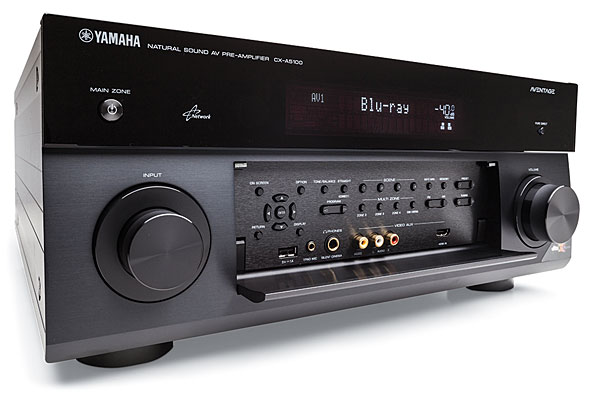
Two-channel performance was almost as enjoyable but didn’t quite reach the jaw-dropping level I hoped for. That’s not to say the Yamaha sounded bad here—it featured a smooth presentation, clear vocals, and an engaging experience—but compared with what I’ve heard in my room from the Krell Foundation ($6,500, review at soundandvision.com) or my Marantz AV-8802A reference pre/pro ($4,000), it wasn’t quite as transparent and alive. This was apparent not only with high-resolution files downloaded from HDtracks but also with ripped CDs on my server as well as some SACD and DVD-Audio discs I played.
One song that stood out was Marti Jones’ “Second Choice” (Live at Spirit Square, Sugar Hill, 1996). The recording blew me away with crystal-clear dynamics, just like I’m used to with the Marantz, but the two pre/pros definitely sounded different. I switched through the various YPAO settings (Manual, Flat, Natural, and Through). Flat sounded the best with prioritized vocals, but the pluck of the bass guitar and the kick of the drum were slightly more laid-back than I’ve grown accustomed to over my past six months with the Marantz. Still, it was just a different sonic signature, and some may prefer the smoother sound of the Yamaha.
Conclusion
I’ve really enjoyed my time with the Yamaha CX-A5100, and frankly, I could live with this pre/pro in a heartbeat if I hadn’t recently upgraded. The two-channel performance sounds fantastic (if slightly different from what I’m used to), and for movies, which are my passion, this beast kicks some serious tail. With the promise of a DTS:X upgrade in the works (which may be in place by the time you read this), it has everything a movie buff needs to get away from the real world. Highly recommended.
PROS
-Unrivaled sound quality in its class
-Processes all current gen audio or video sources
-Plenty of HDMI inputs
-150 watts of clean consistent power
-Bragging rights
CONS
-Non-backlit remote
-Eats up rack space
-Pretty pricey
INTRO
Yamaha launched its AVENTAGE audiophile receivers in 2010, and since that time they have dominated the marketplace. Being user-friendly compared to other brands, offering the ability to stream music between all connected Yamaha devices with MusicCast, and all while offering superb sound quality at price points between $400 and $5000, it’s easy to see why.
Reviewed here are the AVENTAGE line’s flagship pairing from my personal setup — the CX-A5100 11.2 channel MusicCast preamplifier and MX-A5000 11 channel power amplifier. Capable of everything from 2.0 stereo to full 7.2.4 Dolby Atmos, and every configuration in between; while handling 3D or 4K signals. The A5100 will process just about anything you can currently throw at it!

DESIGN & ERGONOMICS
Coming in at 86lbs between the two components and requiring over 20″ of vertical rack space, they are a beast of a setup. By and large, if you’ve seen one receiver, you’ve seen them all. That holds especially true for Yamaha, who has poured its resources into engineering better sound quality, rather than having fancier boxes. The remote control is big and sturdy, however not very comfortable to use and its backlighting takes some effort to engage. I’d say Yamaha is assuming most buying this until will be using a universal remote of one sort or another, or use the smartphone app available on iOS and Android devices.
Designed for the most demanding home theater setups, the CX-A5100 preamp comes in at a mere 34lbs, as there are no internal amps. It has a heavy aluminum front panel with a flip down door hiding the more advanced buttons, which I appreciate having access to without a remote. Featuring 8 HDMI inputs (7 in the rear, one in front) and 2 out, each capable of handling 4K UltraHD. Yamaha has wisely minimized component and composite connections in favor of more HDMI inputs (no S-Video at all, makes me wistful somehow). Without the need for speaker binding posts, Yamaha has included 13 balanced XLR outputs in addition to the same number of RCA outputs. There is even a pair of balanced inputs allowing for the best set up possible. The A5100 also has an excellent phono input, oddly an essential feature in light of vinyl’s resurgence.
Not required, but highly recommended, for pairing is the 11-channel MX-A5000 amplifier. The A5000 is a 56lb large monolithic matte black box, roughly the size of the A5100, with a single round button in the middle. Naturally, the two look made for one another. The A5000 and A5100 feature 12v trigger interconnects, which powers the amplifier on and off with the preamp. The A5000 even has a trigger passthrough allowing you to connect more amplifiers (zone 2 and subwoofer amplifiers). The binding posts are nicely separated on the rear, allowing installation with minimal finger cramping and can easily accommodate 12-gauge wiring. Surprise surprise, the A5100 has 11 balanced as well as RCA inputs. Balanced cables, also known as Microphone cables, are really designed for extremely long runs without interference.
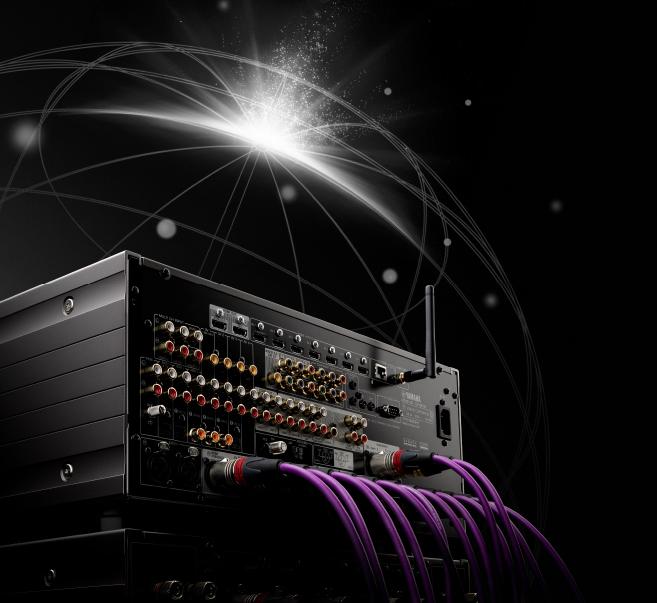
Considering most people will be using 3ft interconnects, good RCA will likely sound just as good. Balanced interconnects are for more nitpicky audiophiles. That being said, I use the balanced connections, as it looks really cool.
Setting up just about any modern home theater receiver can seem daunting. Yamaha has done a better job with making this task user-friendly compared to other brands. You’ll need to consult the manual to figure out ideal speaker placement, especially if you’re going for Dolby Atmos or DTS:X. Yamaha’s guided setup allows you select the number of speakers, their configuration, how many subwoofers you have and where they are in the room. Using the calibration mic, the A5100 can automatically configure ideal settings using YPAO 3D acoustics optimization, 64-bit precision EQ calculation and angle measurements for up to six listening positions. No matter where I’m sitting in my media room, I don’t feel I’m missing much by not being dead center.
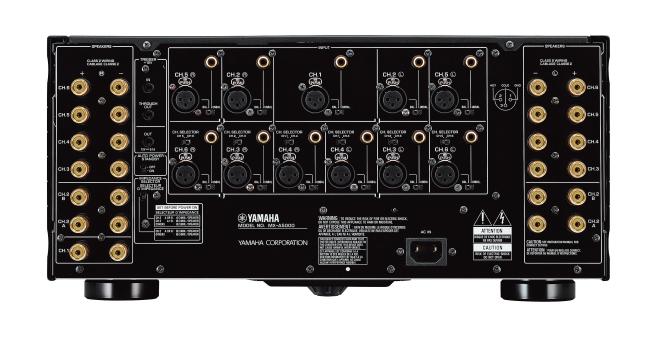
TECHNOLOGY
Thanks to MusicCast, the A5100 can stream audio on up to 9 devices from any source inputs, from Bluetooth to turntables. You can also connect a zone 2 amplifier, and using HDMI Out 2 allows unprecedented control of audio and video in another room. Additionally, the A5100 comes equipped with Airplay and Bluetooth streaming. When connected to the internet via LAN or built-in WiFi, users will have two-way control of streaming services like Pandora, Rhapsody, Sirius, etc.
Yamaha has included video processing/upscaling, in addition to a “high-resolution music enhancer”. Yamaha claims it can take compressed music and “enhance” it to sound like 96/24khz high-resolution audio. There area a plethora of custom settings to adjust in the menu as well. Lastly, a small thing but one of my favorite features — the A5100 can set its power-on volume to whatever level you choose. (Mine is set to a comfortable -35 dB; finally, that stupid MGM lion can’t induce a cardiac episode before the display comes on!)
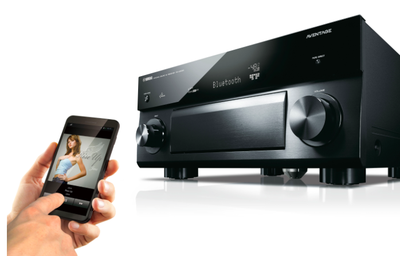
MOVIES & TV PERFORMANCE
MUSIC PERFORMANCE
I’ve spent a lot of time with this setup, and have been completely spoiled by it. Fun fact: the A5000 amp actually outputs 170wpc when only two channels are running. Even streaming 320kbps via Bluetooth from my phone provides an excellent listening experience, whether it truly enhances lossy MP3s I can’t say. Listening to vinyl records via my Technics SL-1200 turntable with the Yamaha set to “Pure Direct” is one of my favorite things to do, the A5100 provides a completely transparent experience. In fact, the difference of MP3 vs a vinyl record would be apparent to even casual listeners on this setup. If anything were to distort, it would pretty definitely be the fault of the speakers. With good speakers, you will hear every nuance of what is on the record (be sure they are squeaky clean).
The A5100 is capable of multiple DSP modes to augment the sound, such as replicating the acoustics of a cathedral or music hall. While it’s fun to play with, I’d never use it for critical listening. I find the most impressive DSP is “Recital/Opera” when combined with a comedy special filmed in a club, it can make it sound/feel like your in the club, with people laughing around you, and a sense of realness added to the comedian. It creates the illusion that your speakers are stage monitors.
FINAL THOUGHTS
The Yamaha AVENTAGE CX-A5100 and MX-A5000 combine for a whopping $5000 MSRP, but as an audiophile, this is a bargain. Delivering 4k passthrough, 11.2 channels of amplification, 8 HDMI 2.2, HDCP 2.0 inputs, it’s a giant Swiss Army knife of a setup, and about as future-proof as it gets.
Yes, the AVENTAGE RX-A3060 can do much of what the A5100/A5000 do, but without the 150wpc of solid amplification.
However, if you’re looking for the very best in audio performance while enjoying just about every modern bell and whistle, and don’t want to worry about format compatibility, look no further.
Highly Recommended!
If you’re interested in buying either piece of gear, please consider supporting High-Def Digest by purchasing via the Amazon links on this page. It adds no extra cost to you and helps keep our lights on.
Description
Absolute quality for when the very best is your option. With years of expertise in designing audio / video receivers and preamplifier processors, Yamaha has gone a step further with its highest offering in the AVENTAGE lineup. Meet the CX-A5100 preamp processor, built from the ground up to be a powerhouse for the most demanding of home theater enthusiasts. Experience three-dimensional surround sound formats with the next generation in audio / video technologies like never before. Tap into advanced Yamaha digital signal processing with CINEMA DSP HD3, utilize the best built-in functions for customization and enjoy the latest home theater technologies that are offered today. Now with MusicCast, this device can be expanded to deliver wireless multiroom audio playback, all controlled by a simple app.
- AVENTAGE build standards designed to deliver the highest level of audio performance
- Aluminum front panel, H-shape cross member frame and rigid bottom frame
- 11.2-channel preamplifier with balanced XLR outputs (including subwoofer outputs)
- Dolby Atmos® and DTS:X™ up to 7.2.4-channel
- CINEMA DSP HD3 expands the sound field vertically for more thrilling and realistic surround sound
- Add audio in up to 9 additional rooms with MusicCast
- Voice control using your Alexa device like Echo or Echo Dot
- 8-in, 2-out HDMI® with 4K Ultra HD pass-through and upscaling
- Advanced HDMI zone switching (Zone 2)
- HDCP 2.2, high dynamic range (HDR) and BT.2020 compatibility
- Professional digital-to-analog conversion (ESS SABRE™ Ultra DAC ES9016S) for all channels
- Fully loaded with Wi-Fi®, Bluetooth, AirPlay® and Spotify Connect
- Stream Pandora®, Spotify, Napster, SiriusXM Internet Radio, TIDAL, Deezer and thousands of free internet radio stations
- DSD 2.8 MHz / 5.6 MHz, FLAC / WAV / AIFF 192 kHz / 24-bit, Apple® Lossless 96 kHz / 24-bit playback
- Phono input to connect to your favorite turntable
- Room acoustics optimization using YPAO™- R.S.C. with 3D, 64-bit precision EQ calculation and angle measurement
Absolute Quality, Massive Power. 11-channel power amplifier delivers top-grade AVENTAGE Series performance. With specially designed high rigidity chassis and the highest quality parts this amplifier creates a balanced connection for optimum performance.
- 150 W per channel (8 ohms, 20 Hz-20 kHz, 0.06% THD, 2-ch driven)
- 170 W per channel (8 ohms, 1 kHz, 0.9% THD, 2-ch driven)
- Custom made, large-size toroidal transformer
- Current feedback power amp with three stage Darlington circuit
- 27,000μF custom block capacitors
- Specially designed high rigidity chassis and highest quality parts
- Noise resistant XLR balanced connections
- Bi-amping capability with channel selector
- High quality gold-plated speaker terminals
- Auto Power Standby
- Handy trigger control (trigger in / out and through out)
- Detachable high quality thick AC power cord












